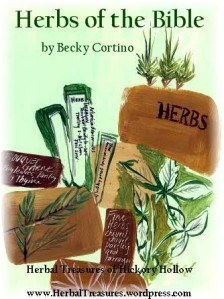 Herbs of the Bible: Home Study Course Available
Herbs of the Bible: Home Study Course Available
As a reader of this blog, you already well know that herbs are a passion of mine and I have studied their many facets since 1980. In my study, I became interested in the history and use of herbs through the ages.
During the last 10 years, I learned about their interesting history, tradition and symbolism, as well as many ways to use them. In this process, I discovered many others are also interested in learning more about them. It has been a thrill to teach Herbs of the Bible Workshops, in addition to writing about them for the last 10 years.
As a result of my learning, teaching and writing process, I have designed and produced an “Herbs Through the Bible and the Ages… and at Eastertide” online home study course:
Biblical references give us a key to tracing the fascinating existence and use of herbs throughout time. Though impossible to recount all herbal history in a single volume as in this audiobook presentation, recounting historical significance points out that the relevancy of herbs in everyday life still remains true today. Shown through hand-picked plant selections and insights shared, Herbs of the Bible is based upon self-directed herbal study that began in 1980, faithfully presented since 2000.
The running time of the audio portion of this online self-paced home study course is over 1 hour, divided into 6 topical segments, including:
Introduction to Herbs through the Bible and Ages, Veracity of Plant Identification, and Herbal Use since Time Began
Selected Plant References to Familiar Plants
Lingering Questions Answered About the First Garden – the Garden of Eden… and was That Really an Apple Eve gave Adam?
Herbal References Related to Passover, Jesus’ Crucifixion, Christmas and Our Gardens Today
Suggested Plant Selections for a Bible Garden, and Creating Your Own Bible Garden
About the Fascinating Passion Flower
…and at Eastertide – 3 Downloadable EBooks:
Easter Herbal EBook: Including Spring Decorating Ideas and Coloring Easter Eggs Naturally with Ingredients You Already Have at Home
Easter Cookies EBook: Recipe and Story for a Hands-on Family Activity, in a Lovely Colorful Devotional
Herbal Treasures Springthyme Recipes EBook:
Featuring Herbed Egg Recipes, Brunch and Holiday Recipes, Menu Ideas with Herbalicious Outrageously ‘Springthyme’ Flavors and Ingredients that are sure to spark your imagination and ever-so gently wake up everyone’s taste buds after the long winter’s nap! Tried-and-true fresh and herbal flavors steep the very uniquely-delicious recipes in this herby EBook, to inspire Good Friday through Easter Brunch, Family Dinner and Desserts!
***
Based on research, study and presentations given to groups since 2000, also included in this program are downloadable up-to-date resource materials:
Guide to Scripture Gardens You Can Visit Online & In-Person — Worldwide
Herbs of the Bible Recipes EBook
Other Herbs and Plants of the Bible
Resources for Further Study
More…

 Dyeing Eggs — Naturally
Dyeing Eggs — Naturally